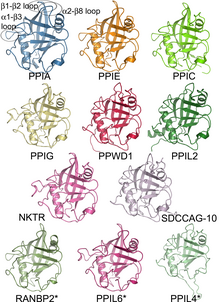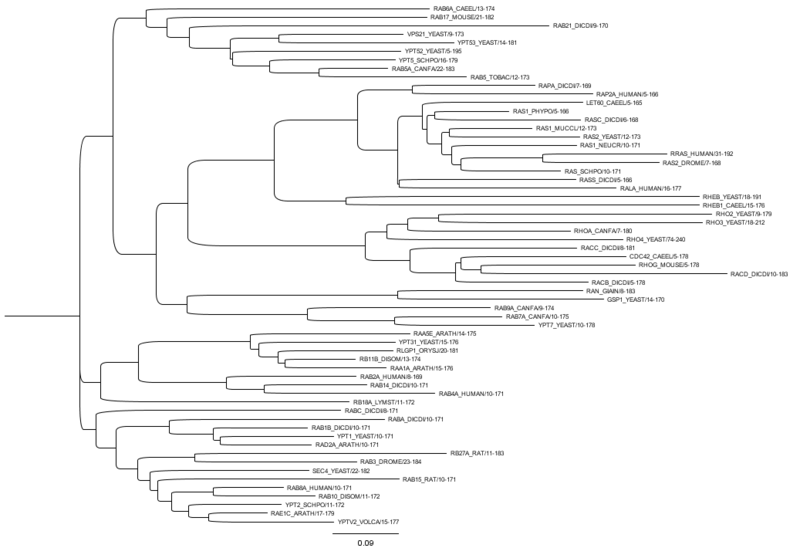
A protein family is a group of evolutionarily related proteins. In many cases, a protein family has a corresponding gene family, in which each gene encodes a corresponding protein with a 1:1 relationship. The term "protein family" should not be confused with family as it is used in taxonomy.
Proteins in a family descend from a common ancestor and typically have similar three-dimensional structures, functions, and significant sequence similarity. [1] [2] Sequence similarity (usually amino-acid sequence) is one of the most common indicators of homology, or common evolutionary ancestry. [3] [4] A fairly well developed framework exists for evaluating the significance of similarity between a group of sequences using sequence alignment methods. Proteins that do not share a common ancestor are unlikely to show statistically significant sequence similarity, making sequence alignment a powerful tool for identifying the members of protein families. [3] [4] Families are sometimes grouped together into larger clades called superfamilies based on structural similarity, even if there is no identifiable sequence homology.
Currently, over 60,000 protein families have been defined, [5] although ambiguity in the definition of "protein family" leads different researchers to highly varying numbers.
Terminology and usage
As with many biological terms, the use of protein family is somewhat context dependent; it may indicate large groups of proteins with the lowest possible level of detectable sequence similarity, or very narrow groups of proteins with almost identical sequence, function, and three-dimensional structure, or any kind of group in between. To distinguish between these situations, the term protein superfamily is often used for distantly related proteins whose relatedness is not detectable by sequence similarity, but only from shared structural features. [6] [7] [8] These terms are used hierarchically. At the highest level of classification are superfamilies, which group distantly related proteins, often based on their structural similarity. [9] Following superfamilies are families, which group proteins with a shared evolutionary origin and have significant sequence similarity. [2] [10] In some cases, proteins are further grouped into subfamilies, which are small groups of closely related proteins that often have similar or identical functions. [11] Hence, a superfamily, such as the PA clan of proteases, has far lower sequence conservation than one of the families it contains, the C04 family.
Protein domains and motifs
The concept of protein family was conceived when very few protein structures or sequences were known. At the time, the majority of proteins that were structurally understood were small, single-domain proteins such as myoglobin, hemoglobin, and cytochrome c. Since then, many proteins have been found with multiple independent structural and functional units or domains. Due to evolutionary shuffling, different domains in a protein have evolved independently. This has led to a focus on families of protein domains. A number of online resources are devoted to identifying and cataloging such domains. [12] [13]
Different regions of a protein have differing functional constraints (features critical to the structure and function of the protein). For example, the active site of an enzyme requires certain amino-acid residues to be precisely oriented in three dimensions. A protein–protein binding interface, though, may consist of a large surface with constraints on the hydrophobicity or polarity of the amino-acid residues. Functionally constrained regions of proteins evolve more slowly than unconstrained regions such as surface loops, giving rise to discernible blocks of conserved sequence when the sequences of a protein family are compared (see multiple sequence alignment). These blocks are most commonly referred to as motifs, although many other terms are used (blocks, signatures, fingerprints, etc.). Again, many online resources are devoted to identifying and cataloging protein motifs. [14]
Evolution of protein families
According to current consensus, protein families arise in two ways. First, the separation of a parent species into two genetically isolated descendant species allows a gene/protein to independently accumulate variations ( mutations) in these two lineages. This results in a family of orthologous proteins, usually with conserved sequence motifs. Second, a gene duplication may create a second copy of a gene (termed a paralog). Because the original gene is still able to perform its function, the duplicated gene is free to diverge and may acquire new functions (by random mutation).
Certain gene/protein families, especially in eukaryotes, undergo extreme expansions and contractions in the course of evolution, sometimes in concert with whole genome duplications. Expansions are less likely, and losses more likely, for intrinsically disordered proteins and for protein domains whose hydrophobic amino acids are further from the optimal degree of dispersion along the primary sequence. [15] This expansion and contraction of protein families is one of the salient features of genome evolution, but its importance and ramifications are currently unclear.

Use and importance of protein families
As the total number of sequenced proteins increases and interest expands in proteome analysis, an effort is ongoing to organize proteins into families and to describe their component domains and motifs. Reliable identification of protein families is critical to phylogenetic analysis, functional annotation, and the exploration of the diversity of protein function in a given phylogenetic branch. The Enzyme Function Initiative uses protein families and superfamilies as the basis for development of a sequence/structure-based strategy for large scale functional assignment of enzymes of unknown function. [16] The algorithmic means for establishing protein families on a large scale are based on a notion of similarity.
Protein family resources
Many biological databases record examples of protein families and allow users to identify if newly identified proteins belong to a known family. Here are a few examples:
- Pfam - Protein families database of alignments and HMMs
- PROSITE - Database of protein domains, families and functional sites
- PIRSF - SuperFamily Classification System
- PASS2 - Protein Alignment as Structural Superfamilies v2 - PASS2@NCBS [17]
- SUPERFAMILY - Library of HMMs representing superfamilies and database of (superfamily and family) annotations for all completely sequenced organisms
- SCOP and CATH - Classifications of protein structures into superfamilies, families and domains
Similarly, many database-searching algorithms exist, for example:
- BLAST - DNA sequence similarity search
- BLASTp - Protein sequence similarity search
- OrthoFinder - Method for clustering proteins into families (orthogroups) [18] [19]
See also
Protein families
References
- ^ "What are protein families? Protein classification". EMBL-EBI. Retrieved 2023-11-14.
- ^ a b Orengo, Christine; Bateman, Alex (2013). "Introduction". In Orengo, Christine; Bateman, Alex (eds.). Protein Families: Relating Protein Sequence, Structure, and Function. Hoboken, New Jersey: John Wiley & Sons, Inc. pp. vii–xi. doi: 10.1002/9781118743089.fmatter. ISBN 9781118743089.
- ^ a b Pearson, William R. (2013). "An Introduction to Sequence Similarity ("Homology") Searching". Current Protocols in Bioinformatics. 3: 3.1.1–3.1.8. doi: 10.1002/0471250953.bi0301s42. ISSN 1934-3396. PMC 3820096. PMID 23749753.
- ^ a b Chen, Junjie; Guo, Mingyue; Wang, Xiaolong; Liu, Bin (2018-03-01). "A comprehensive review and comparison of different computational methods for protein remote homology detection". Briefings in Bioinformatics. 19 (2): 231–244. doi: 10.1093/bib/bbw108. ISSN 1477-4054. PMID 27881430.
- ^ Kunin, Victor; Cases, Ildefonso; Enright, Anton J.; de Lorenzo, Victor; Ouzounis, Christos A. (2003). "Myriads of protein families, and still counting". Genome Biology. 4 (2): 401. doi: 10.1186/gb-2003-4-2-401. ISSN 1474-760X. PMC 151299. PMID 12620116.
- ^ Dayhoff, MO (December 1974). "Computer analysis of protein sequences". Federation Proceedings. 33 (12): 2314–6. PMID 4435228.
- ^ Dayhoff, MO; McLaughlin, PJ; Barker, WC; Hunt, LT (1975). "Evolution of sequences within protein superfamilies". Die Naturwissenschaften. 62 (4): 154–161. Bibcode: 1975NW.....62..154D. doi: 10.1007/BF00608697. S2CID 40304076.
- ^ Dayhoff, MO (August 1976). "The origin and evolution of protein superfamilies". Federation Proceedings. 35 (10): 2132–8. PMID 181273.
- ^ Orengo, Christine A.; Thornton, Janet M. (2005-06-01). "Protein Families and Their Evolution—A Structural Perspective". Annual Review of Biochemistry. 74 (1): 867–900. doi: 10.1146/annurev.biochem.74.082803.133029. ISSN 0066-4154. PMID 15954844.
- ^ Veeramachaneni, Vamsi; Makałowski, Wojciech (2004). "Visualizing Sequence Similarity of Protein Families". Genome Research. 14 (6): 1160–1169. doi: 10.1101/gr.2079204. ISSN 1088-9051. PMC 419794. PMID 15140831.
- ^ Holm, Liisa; Heger, Andreas (2013). "Automated Sequence-Based Approaches for Identifying Domain Families". In Orengo, Christine; Bateman, Alex (eds.). Protein Families: Relating Protein Sequence, Structure, and Function. Hoboken, New Jersey: John Wiley & Sons, Inc. pp. 1–24. doi: 10.1002/9781118743089.ch1. ISBN 9781118743089. S2CID 85641264.
- ^ Wang, Yan; Zhang, Hang; Zhong, Haolin; Xue, Zhidong (2021-01-01). "Protein domain identification methods and online resources". Computational and Structural Biotechnology Journal. 19: 1145–1153. doi: 10.1016/j.csbj.2021.01.041. ISSN 2001-0370. PMC 7895673. PMID 33680357.
- ^ Bateman, Alex (2013). "Sequence Classification of Protein Families: Pfam and other Resources". In Orengo, Christine; Bateman, Alex (eds.). Protein Families: Relating Protein Sequence, Structure, and Function. Hoboken, New Jersey: John Wiley & Sons, Inc. pp. 25–36. doi: 10.1002/9781118743089.ch2. ISBN 9781118743089.
- ^ Mulder, Nicola J.; Apweiler, Rolf (2001-12-19). "Tools and resources for identifying protein families, domains and motifs". Genome Biology. 3 (1): reviews2001.1. doi: 10.1186/gb-2001-3-1-reviews2001. ISSN 1474-760X. PMC 150457. PMID 11806833.
- ^ James, Jennifer E; Nelson, Paul G; Masel, Joanna (4 April 2023). "Differential Retention of Pfam Domains Contributes to Long-term Evolutionary Trends". Molecular Biology and Evolution. 40 (4): msad073. doi: 10.1093/molbev/msad073. PMC 10089649. PMID 36947137.
- ^ Gerlt, John A.; Allen, Karen N.; Almo, Steven C.; Armstrong, Richard N.; Babbitt, Patricia C.; Cronan, John E.; Dunaway-Mariano, Debra; Imker, Heidi J.; Jacobson, Matthew P.; Minor, Wladek; Poulter, C. Dale; Raushel, Frank M.; Sali, Andrej; Shoichet, Brian K.; Sweedler, Jonathan V. (2011-11-22). "The Enzyme Function Initiative". Biochemistry. 50 (46): 9950–9962. doi: 10.1021/bi201312u. ISSN 0006-2960. PMC 3238057. PMID 21999478.
- ^ Gandhimathi, A.; Nair, Anu G.; Sowdhamini, R. (2012). "PASS2 version 4: An update to the database of structure-based sequence alignments of structural domain superfamilies". Nucleic Acids Research. 40 (D1): D531–D534. doi: 10.1093/nar/gkr1096. ISSN 1362-4962. PMC 3245109. PMID 22123743.
- ^ Emms, David M.; Kelly, Steven (2015-08-06). "OrthoFinder: Solving fundamental biases in whole genome comparisons dramatically improves orthogroup inference accuracy". Genome Biology. 16 (1): 157. doi: 10.1186/s13059-015-0721-2. ISSN 1474-760X. PMC 4531804. PMID 26243257.
- ^ Emms, David M.; Kelly, Steven (2019-11-14). "OrthoFinder: Phylogenetic orthology inference for comparative genomics". Genome Biology. 20 (1): 238. doi: 10.1186/s13059-019-1832-y. ISSN 1474-760X. PMC 6857279. PMID 31727128.
External links
-
 Media related to
Protein families at Wikimedia Commons
Media related to
Protein families at Wikimedia Commons
